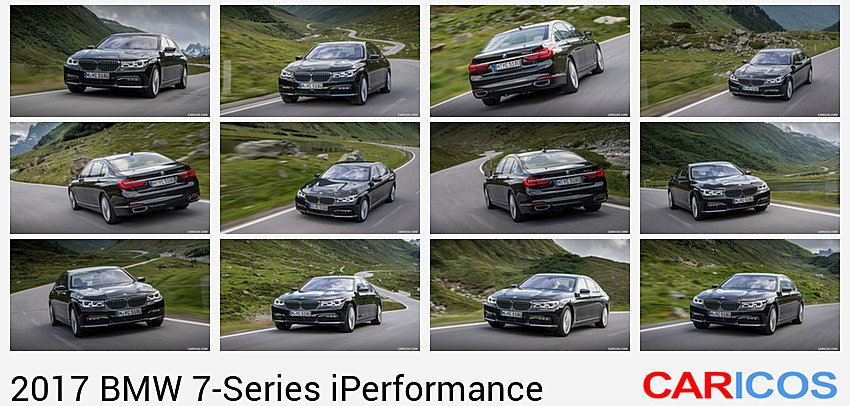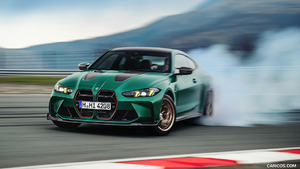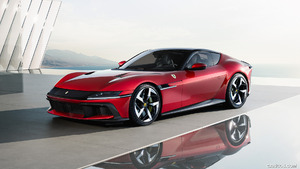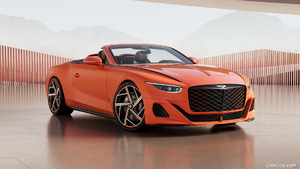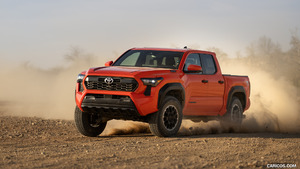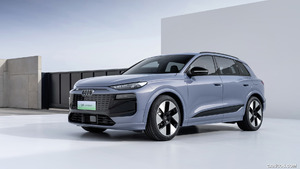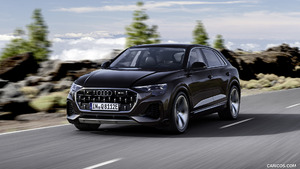BMW 7-Series iPerformance
BMW i technology for the luxury class: The new BMW 740e iPerformance, the new BMW 740Le iPerformance, the new BMW 740Le xDrive iPerformance
The pioneering character of the new BMW 7 Series model range is thrust into the spotlight once again with the introduction of an intelligent drive concept that is as innovative as it is intelligent. The BMW eDrive technology based on the knowledge gained from the development of BMW i cars has arrived in the luxury class and adds outstanding sustainability-led qualities to the established leadership credentials of the new BMW 7 Series. The trio of luxury sedans the BMW premium brand is presenting at the pinnacle of its model line-up are powered by a plug-in hybrid drive system using the precisely executed interplay of a four-cylinder petrol engine with BMW TwinPower Turbo technology and an electric motor integrated into the eight-speed Steptronic transmission to generate a system output of 240 kW/326 hp. The new BMW 740e iPerformance with standard wheelbase and the new BMW 740Le iPerformance with long wheelbase capture the imagination with supreme dynamics, yet also record average petrol consumption of 2.2 – 2.0 litres per 100 kilometres (128.4 – 141.2 mpg imp) and CO2 emissions of 50 – 45 grams per kilometre (BMW 740Le iPerformance: 51 – 45 grams per kilometre). In the new BMW 740Le xDrive iPerformance (petrol consumption combined: 2.5 – 2.1 l/100 km [113 – 134.5 mpg imp]; CO2 emissions combined: 56 – 49 g/km), intelligent all-wheel drive distributes the combined power of the combustion engine and electric motor permanently and as required between the front and rear wheels.
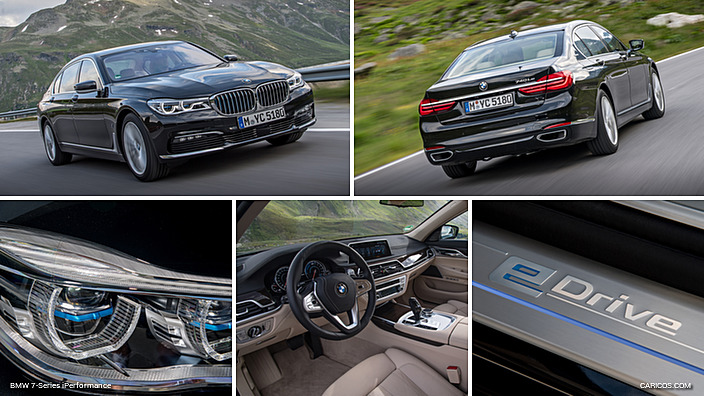 2017 BMW 7-Series iPerformance
2017 BMW 7-Series iPerformance
The plug-in hybrid variants of the new BMW 7 Series allow top-level driving pleasure and long-distance comfort to be experienced with the added virtues of all-electric, locally emission-free mobility. As such, the BMW iPerformance Automobiles represent the most rigorous implementation yet of Efficient Dynamics in vehicles from the BMW brand. Their BMW eDrive technology teams up with intelligent energy management, an extensive weight-reduction programme under the banner of BMW EfficientLightweight and innovative aerodynamics optimisation measures.
The BMW Group defined the gaugeable sustainability targets for the new BMW 7 Series – spanning the vehicle’s entire life cycle – in the early strategic phase of development and actively implemented them throughout the development process. The environmental impact termed the “greenhouse potential”, which is measured on the basis of the CO2e emissions produced by everything from the extraction of raw materials through the entire manufacturing and usage phase to recycling at the end of the vehicle’s life, is around 30 per cent lower than in the predecessor model. The results and the life cycle assessment process have been independently certified in accordance with ISO 14040/44 taking the example of a BMW 740Li. These improvements have been achieved through measures including the use of secondary aluminium in cast components and recycled plastics, and by increasing the proportion of power from renewable sources used in vehicle production. The BMW eDrive technology in the BMW 740Le iPerformance ensures its greenhouse potential (CO2e) is a further 27 per cent or so lower than that of the conventionally powered BMW 740Li over the full lifecycle of the car (mileage: 250,000 kilometres [approx. 155,300 miles], fuel consumption as calculated in the EU test cycle for plug-in hybrid vehicles).
Like the BMW eDrive technology for the plug-in hybrid variants of the new BMW 7 Series, their intelligent lightweight design featuring carbon-fibrereinforced plastic (CFRP) is also based on singular expertise forged in the development of BMW i cars. The body structure with Carbon Core first presented in the new BMW 7 Series is the result of the BMW Group’s accumulated know-how in the industrial use of CFRP, which is unparalleled in the automotive industry. Experience gathered at BMW i has also been used in the model-specific configuration of the electric motor, power electronics and lithium-ion high-voltage battery. Customers can rely on innovative products and mobility services originally developed for BMW i cars, such as the BMW i Wallbox and the ChargeNow service, for charging the high-voltage battery at home and during a journey. In addition, the BMW 740e iPerformance, BMW 740Le iPerformance and BMW 740Le xDrive iPerformance can be specified as an option with anti-dazzle BMW Laserlight including BMW Selective Beam, which celebrated its world premiere in the BMW i8 plug-in hybrid sports car.
The BMW eDrive technology tailored specifically for the plug-in hybrid members of the new BMW 7 Series family paves the way for a new form of authoritative driving pleasure in a luxury sedan. Intelligent energy management optimises the interplay of the combustion engine and electric motor, adding another innovative facet to a driving experience defined by sporty handling, outstanding long-distance comfort and a luxurious interior ambience. The electric boost function provides a noticeable increase in dynamic vigour – expressed most prominently by the powertrain’s instantaneous responses – and combines with enhanced efficiency courtesy of the electric assist function and the opportunity to drive through town and cross-country on electric power only (and therefore locally emission-free) to create a unique symbiosis of driving pleasure and sustainability unmatched by any rival. The maximum electric range, as per the EU test cycle for plug-in hybrid vehicles, is 44 – 48 kilometres / 27 – 30 miles for the BMW 740e iPerformance and BMW 740Le iPerformance, or 41 – 45 kilometres / 25 – 28 miles for the BMW 740Le xDrive iPerformance (figures may vary depending on the tyre format specified).
The BMW 7 Series has a long tradition as an innovation showcase for ultrasustainable drive concepts. Back in 1984 the luxury sedan provided the basis for a research vehicle with a hydrogen combustion engine. A succession of other prototypes followed, before the world’s first luxury sedan with hydrogen drive system conceived for everyday use and as part of a full development process was unveiled in 2006; the BMW Hydrogen 7 was produced in a small series and – over several million kilometres of testing around the world – provided evidence of its drive concept’s practical feasibility. Further down the line, BMW ActiveHybrid technology celebrated its luxury segment premiere in the predecessor to the new BMW 7 Series. The BMW ActiveHybrid 7 was the world’s first series-produced vehicle in which a V8 petrol engine, an eightspeed Steptronic transmission and an electric drive system had come together as part of a mild-hybrid concept.
The best of two worlds: BMW eDrive and BMW TwinPower Turbo technology.
The plug-in hybrid system of the BM BMW 740e iPerformance, BMW 740Le iPerformance and BMW 740Le xDrive iPerformance brings together the latest innovations from the world of combustion engines and electric drive systems. Here, the BMW Group’s pace-setting development expertise in the field of powertrain technology comes to the fore in concentrated form. The combustion engine with BMW TwinPower Turbo technology employed by the plug-in hybrid variants of the BMW 7 Series belongs to the BMW Group’s new Efficient Dynamics engine family. Developing a maximum output of 190 kW/258 hp, it is the most powerful fourcylinder engine ever fitted in a series-produced BMW. Instantaneous power delivery and peak torque of 400 Newton metres (295 lb-ft) – on tap between 1,550 and 4,400 rpm – imbue the 2.0-litre unit with vivacious yet also poised and authoritative performance.
The package of technology built into the new engine comprises a TwinScroll turbocharger integrated into the cast-steel exhaust manifold, High Precision Injection with a maximum pressure of 200 bar, the latest version of VALVETRONIC variable valve timing and variable camshaft control on both the intake and exhaust sides (Double-VANOS). Balancer shafts with rolling bearing supports in the aluminium crankcase enhance the engine’s refinement, while the close-coupled arrangement of the catalytic converter and an electrically controlled wastegate for the turbocharger optimise its emissions. Moreover, electronically switchable engine mounts provide the connection with the body. These mounts smooth out the vibrations caused by the engine (which vary according to load) as required, ensuring that all occupants experience exceptionally low vibration levels and the engine delivers outstanding refinement.
Since the plug-in hybrid variants of the luxury sedan come with a specific, extremely powerful starter motor for the combustion engine and a compressor for the climate control system that operates using energy from the high-voltage battery, the petrol engine is equipped with a special belt drive. This removes the need to integrate the generator and refrigerant compressor as required in conventionally powered vehicles. A large proportion of the engine’s output and torque is therefore available to be converted into dynamic performance.
The electric motor also displays hallmark BMW performance characteristics. Based on the principle of a permanently excited synchronous motor, the electric drive system stands out with its linear power delivery up into the higher reaches of the rev range and its exceptionally high level of efficiency. Its maximum output is 83 kW/113 hp. And, as is characteristic for electric drive systems, it serves up its peak torque of 250 Newton metres (184 lb-ft) from the word go. The boost effect for the combustion engine provides thrilling, instantaneous responsiveness and power build-up with absolutely no delay when accelerating from stationary, as well as far more dynamic performance whenever a quick burst of speed is required. Furthermore, the electric motor also takes on the role of a generator – powered, depending on the hybrid function selected, either by recuperating energy on the overrun and under braking or by efficiently raising the engine’s load points. It then feeds the energy it generates into the high-voltage battery.
The electric motor is fully integrated into the car’s eight-speed Steptronic transmission. This ensures that pure-electric driving, the dynamics-enhancing electric boost function and the recuperation of braking energy all happen extremely efficiently. The integration of the electric motor also means the transmission does not require a torque converter (enabling a reduction in weight), while the hybrid module takes over the function of the starter element. The eight-speed Steptronic transmission combines efficiency with shift dynamics and shift comfort at a high level. The transmission’s broad spread of ratios helps the car to pull away quickly under acceleration but also promotes low energy consumption when driving at higher speeds. The small rev intervals on upshifts and downshifts benefit both sports performance and driving comfort. Gearshift paddles on the steering wheel are available as an option, enabling the driver to make manual gear selections with exceptional swiftness and the greatest of ease.
Working together intelligently, the combustion engine and electric drive system bring a system output of 240 kW/326 hp and combined peak torque of 500 Newton metres (369 lb-ft) to the table. Immediate response to every movement of the accelerator and sustained delivery of dynamic power allow the BMW 740e iPerformance to dash from 0 to 100 km/h (62 mph) in 5.4 seconds and the BMW 740Le iPerformance to complete the same sprint in 5.5 seconds. The top speed of both models is electronically limited to 240 km/h (149 mph).
Their sporty driving characteristics are accompanied by extraordinarily low consumption and emissions for members of the luxury sedan class. The BMW 740e iPerformance and BMW 740Le iPerformance post combined petrol consumption of 2.2 – 2.0 litres per 100 kilometres (128.4 – 141.2 mpg imp). The CO2 emissions associated with petrol consumption are 50 – 45 grams per kilometre (BMW 740Le iPerformance: 51 – 45 g/km; figures as calculated in the EU test cycle for plug-in hybrid vehicles, may vary depending on the tyre format specified). The exceptional efficiency of the BMW eDrive technology developed using know-how from BMW i is revealed once again in all-electric, locally emission-free driving. The electric power consumption of the plug-in hybrid luxury sedans, as calculated in the EU test cycle, stands at 13.3 – 12.5 kWh per 100 kilometres for the BMW 740e iPerformance and 13.3 – 12.6 kWh per 100 kilometres for the BMW 740Le iPerformance (figures may vary depending on the tyre format specified).
BMW 740Le xDrive iPerformance: permanent all-wheel drive also applies to pure-electric driving.
BMW eDrive technology is flexible in the ways in which it can be deployed, paving the way for the integration of a plug-in hybrid drive system into different segments and BMW brand models. BMW eDrive can be combined with a large number of combustion engines and model-specific drive concepts as part of made-to-measure solutions. In the BMW 740e iPerformance and BMW 740Le iPerformance the drive delivered by the hybrid system is channelled to the road via the classical route through the rear wheels. The BMW 740Le xDrive iPerformance follows in the tyre tracks of the BMW X5 xDrive40e iPerformance Sports Activity Vehicle as the brand’s second model to distribute its power permanently to all four wheels in all drive combinations – i.e. in pure-electric mode, when the combustion engine cuts in and when both drive systems are in use at the same time.
The intelligent all-wheel-drive system ensures supreme traction, optimised directional stability and enhanced agility through enthusiastically taken corners in all weather and road conditions. An electronically controlled multi-plate clutch enables the fully variable distribution of the engine’s power between the front and rear wheels. By linking up with DSC (Dynamic Stability Control), the xDrive system can act in advance to counter understeer or oversteer and direct the power from the engine and motor in such a way as to optimise handling dynamics at all times.
Perfectly executed power distribution gives the BMW 740Le xDrive iPerformance extremely dynamic accelerative ability. Indeed, the journey from rest to 100 km/h (62 mph) is all over in 5.3 seconds. And yet the combined petrol consumption of the BMW 740Le xDrive iPerformance is 2.5 – 2.1 litres per 100 kilometres (113 – 134.5 mpg imp) and CO2 emissions come in at 56 – 49 grams per kilometre (figures as calculated in the EU test cycle for plug-in hybrid vehicles, may vary depending on the tyre format specified). The combined electric power consumption of the BMW 740Le xDrive iPerformance in the EU test cycle is between 13.9 and 13.2 kWh per 100 kilometres (figures may vary depending on the tyre format specified).
eDrive button on the centre console allows powertrain control to be configured as desired.
The eDrive button on the centre console allows the driver to select from the AUTO eDRIVE, MAX eDRIVE and Battery Control settings, and so determine the operating approach of the plug-in hybrid drive system. AUTO eDRIVE, which is automatically activated when the vehicle starts up, uses intelligent energy management to ensure the combustion engine and electric motor work together to the best possible effect in terms of both efficiency and dynamics. The operating strategy defaults to all-electric mode at low and moderate speeds to utilise the advantages of locally emission-free mobility as widely as possible. The combustion engine only joins the fray at a speed of around 80 km/h (50 mph) or under heavy throttle applications. The modelspecific starter motor ensures the switch from pure-electric to hybrid mode takes place extremely smoothly.
The electric drive system also delivers additional torque through its boost function when the combustion engine is in play and high levels of power are required. This configuration comes to the fore in the form of conspicuously instantaneous responses and a noticeable increase in pulling power at all times – which lends the engine the character of a unit with a far larger displacement. Pooling the torque of the engine and electric motor imbues the driving characteristics of the new plug-in hybrid BMW 7 Series variants with remarkable poise and assurance. When the driver demands a burst of acceleration, it arrives in a dynamically enhanced package. Furthermore, the electric Assist function enables a targeted lowering of the engine’s load points when greater power is summoned, and that enhances its efficiency. Whenever the navigation system’s route guidance function is activated, proactive energy management adapts the drive system’s operating strategy to optimise efficiency. Furthermore, it ensures the high-voltage battery has sufficient charge remaining to reach the selected destination in the pureelectric driving mode.
The driver can switch to the MAX eDRIVE operating function at the touch of a button. In this setting, the car is powered exclusively by the electric motor, although the combustion engine can be activated at any time by pushing the accelerator into kickdown. The BMW iPerformance variants of the new BMW 7 Series model range can hit a top speed of 140 km/h (87 mph) by means of the electric motor alone. And that means the driver can enjoy relaxed, efficient and locally emission-free mobility not only in city traffic, but also on cross-country journeys.
The Battery Control setting allows the charge of the high-voltage battery to be set manually. The driver can input a target value between 30 and 100 per cent of maximum charge, which is then available for pure-electric driving later in the journey. Depending on the driver’s requirements, the charge of the highvoltage battery is maintained at a constant level or – using the electric motor’s generator function – increased to the target charge level selected. For example, electric power can be held back or even increased while on the motorway so that it can be deployed subsequently for locally emission-free driving in town. This allows the electric energy to be used in a targeted manner and at the desired time.
Regardless of the setting selected via the eDrive button, when the gearshift lever is moved into the S gate the engine comes to life as required to ensure the maximum combined output of the two drive systems is permanently on tap.
Driving Experience Control switch with ADAPTIVE mode, clearly noticeable differentiation between SPORT, COMFORT and ECO PRO mode.
The plug-in hybrid variants of the new BMW 7 Series are also fitted as standard with the newly designed Driving Experience Control switch on the centre console. At the touch of a button, the driver can activate a vehicle setting that optimises dynamics, comfort or efficiency. Their selection adjusts the characteristics of the accelerator and steering, the shift profile of the Steptronic transmission and the responses of the Dynamic Damper Control system. The range of characters encompassed by the ECO PRO, COMFORT and SPORT modes are even more clearly defined than with conventionally powered vehicles.
COMFORT mode – which is automatically engaged when the driver starts the car – provides the plug-in hybrid BMW 7 Series models with a smoothly balanced overall set-up. In this mode, the electric motor delivers relaxed driving with the lowest possible energy consumption. In SPORT mode the power of both the combustion engine and the electric motor teams up with stiff damper settings, instantaneous responses to movements of the accelerator, sharper shift dynamics and direct steering characteristics to maximise dynamic performance. The electric boost function is stepped up a level in SPORT mode, as is recuperation performance under braking and on the overrun.
The hybrid-specific version of the ECO PRO mode supports an operating strategy which aims to maximise the car’s electric range. As a result, the electric boost function supplementing the power of the combustion engine is only activated if the accelerator is pushed into kickdown. Energy recuperation on the overrun also takes a limited form. Instead, a hybrid-specific coasting function is triggered at speeds between 40 and 160 km/h (25 – 99 mph). As soon as the driver releases the accelerator, the combustion engine is switched off. In addition, recuperation of braking energy is reduced to the level required by the onboard power supply. The car therefore runs on the minimum possible energy consumption and with the lowest possible mechanical resistance. Furthermore, as with the other models in the new BMW 7 Series line-up, ECO PRO mode features precisely gauged power control for electrically operated convenience functions, such as the climate control system, seat heating and exterior mirror heating.
Furthermore, the Driving Experience Control switch also offers drivers of plugin hybrid variants of the new BMW 7 Series the option of selecting ADAPTIVE mode. In this setting, the car’s responses noticeably adapt to the driver’s style and route profile, taking their cues from movements in the steering wheel, accelerator and brake pedal, as well as from the position of the gearshift lever in the D or S gate. In addition, the navigation system’s map data is used to ensure the right set-up option is made available when the driver switches from city driving to the motorway, for example, as well as on twisty sections of road or when approaching a junction.
High-voltage lithium-ion battery: developed specifically for the models at hand, integrated with space-saving skill.
The high-voltage lithium-ion battery in the BMW 740e iPerformance, BMW 740Le iPerformance and BMW 740Le xDrive iPerformance stands out with its compact construction and has a gross capacity of 9.2 kWh (net capacity: 7.4 kWh). It consists of 96 cells arranged in six modules and has its own cooling system integrated into the climate control system for the interior. The high-voltage battery was developed specifically for this model and is accommodated underneath the rear seat bench in a space-saving position that also ensures optimum crash safety. As in its BMW 7 Series siblings, the boot area of the new BMW iPerformance variants therefore also benefits from a level surface and high-convenience usability. It provides 420 litres of space, which far exceeds that of comparable plug-in hybrid models in the luxury sedan segment, while extra capacity can be gained by using the storage compartment underneath the load compartment floor, lowering the cover in the rear section of the boot or opening the side storage compartments.
The energy flow between the high-voltage battery, electric motor and charger is controlled by power electronics likewise developed specifically for these plug-in hybrid models. The power electronics also regulate the supply of energy from the high-voltage battery to the 12V onboard electrical system via a voltage transformer.
Simple, hassle-free and flexible charging thanks to innovative products and services from BMW 360° ELECTRIC.
The high-voltage battery can be topped up with energy from any domestic power socket, a Wallbox designed for higher currents or public charging stations. The BMW 740e iPerformance, BMW 740Le iPerformance and BMW 740Le xDrive iPerformance come as standard with a charging cable, which is stored in a bag and can be held in place using a tension belt on the left-hand side of the boot.
The battery can be charged to full capacity in under four hours from a domestic power socket, while tailor-made solutions enabling safe, straightforward and rapid charging at home are available through BMW 360° ELECTRIC. The BMW i Wallbox Pure uses its output of 3.7 kW (16 A/230 V) to charge the high-voltage battery in under three hours. The progress of the charging process can be tracked via a graphic in the car’s instrument cluster or the BMW Remote app on a smartphone. A second version of the charging station, the BMW i Wallbox Pro, comes with features including a seven-inch touchscreen, which indicates how charging is progressing and allows customers to choose their own settings governing load management and self-produced electricity.
360° ELECTRIC offers an all-encompassing service concept covering everything from the supply and installation of the charging station to maintenance, advice and other services. And there is also the ChargeNow service, which grants straightforward access to partner charging stations and can also be used for the convenient billing of monthly energy costs.
Instrument cluster and Control Display with hybrid-specific information.
The charger connection for the high-voltage battery, which can be found under the flap in the left-hand front side panel of the BMW 740e iPerformance, BMW 740Le iPerformance and BMW 740Le xDrive iPerformance, points to the trailblazing character of the drive concept at work here, as does the “eDrive” badge on the C-pillars and the door sill plates. The high-set position of the connection makes the charging process easier. The transfer of technology from BMW i is also flagged up by the BMW i logo on the front side panels (left and right), the BMW kidney grille bars in BMW i Blue and blue hub covers. As with the model designation badges on all BMW models, customers can also choose to have these specific design features of BMW iPerformance models deleted. Among the most prominent hybrid-specific features in the interior alongside the eDrive button are the special graphic displays in the instrument cluster and Control Display. The former contains an output gauge showing information on the power from the engine / electric motor currently available or being used, as well as a display indicating the charge level of the highvoltage battery. Furthermore, details on the car’s electric range and overall range can be called up at any one time, as can the current petrol/electric power consumption, the flow of recuperated electric energy into the highvoltage battery and the progress of a charge.
The iDrive operating system also offers hybrid-specific menu items and displays. During the course of a journey, the driver can call up an energy flow graphic providing information on the interplay of the combustion engine and electric motor, as well as the supply of energy into the high-voltage battery. Other Efficiencytainment functions include displays detailing the car’s petrol/electric power consumption history and the distance covered on electric power alone, not to mention a diagram showing how the hybrid system is using navigation data to prepare for an imminent change in the driving situation.
Standard equipment includes auxiliary air conditioning.
The high level of standard specification for the BMW 740e iPerformance, BMW 740Le iPerformance and BMW 740Le xDrive iPerformance includes LED headlights, the BMW Display Key, the ConnectedDrive navigation package, smartphone integration with an inductive charging facility for the phone battery, and an iDrive operating system expanded to include a touchscreen function for the Control Display and the globally unique BMW gesture control feature. Customers can also look forward to auxiliary heating and air conditioning, which allow them to prepare the car’s interior temperature in advance. The heating and air conditioning system of the plugin hybrid models is supplied with energy by the high-voltage battery and works almost silently due to the electric operation of the refrigerant compressor and instantaneous water heater. The auxiliary air conditioning function is powered by the mains supply when the car’s battery is being charged, while a timer function allows the advance preparation of the interior and charging of the battery to be programmed via the iDrive menu.
In addition, the BMW Remote app allows the driver to activate the auxiliary air conditioning function from outside the car via a smartphone. It also supplies information on the charge of the high-voltage battery, the location of public charging stations, the distance covered on electric power alone and the amount of petrol saved as a result.
Exceptional efficiency combined with driving pleasure, longdistance comfort and made-to-measure luxury.
BMW eDrive technology brings together exceptional efficiency and a form of luxurious driving pleasure and long-distance comfort that speaks to both the present and the future. The intelligently controlled interplay of combustion engine and electric motor in the plug-in hybrid models lends extra allure to the hallmark BMW sporting ability of the new 7 Series. Individually adjustable dynamics and comfort are the product of advanced chassis technology, which in the BMW iPerformance variants of the new BMW 7 Series likewise includes two-axle air suspension with automatic self-levelling and Dynamic Damper Control. Integral Active Steering, meanwhile, is available as an option.
Unbeatable occupant protection is provided by an extremely high-strength passenger cell, generously sized deformation zones and precisely defined load paths to redirect impact energy. The positioning of the eDrive technology components guarantees them optimum protection. In the plug-in hybrid models, the integrated safety concept of the BMW 7 Series also includes the battery management system for the high-voltage unit. Among the other items of standard safety equipment on board are front and side airbags, head/curtain airbags for the front and rear rows of seats, a knee airbag on the driver’s side, active head restraints, three-point inertia-reel seat belts with belt force limiters and belt tensioners in the front seats, ISOFIX child seat mountings in the rear and the Active Protection system.
Another item on the list of standard equipment is the Ambient light function, which includes the Welcome Light Carpet and – in the BMW 740Le iPerformance and BMW 740Le xDrive iPerformance – the Ambient highlight in the rear compartment. Among the optional features providing an exceptionally luxurious way to cover the miles are the Bowers & Wilkins Diamond Surround Sound System and the Ambient Air package. Customers can also specify comfort seats, active seat ventilation, the massage function with Vitality Programme and the Heat Comfort package for both front and rear seats. The Executive Lounge option brings an unbeatable sense of personal wellbeing to the rear of the BMW 740Le iPerformance and BMW 740Le xDrive iPerformance, while the Sky Lounge Panorama glass roof is also available for these models as an option.
The selection of driver assistance systems includes the new-generation BMW Head-Up Display as well as the Parking Assistant, Driving Assistant, Driving Assistant Plus and Surround View systems. The BMW iPerformance variants of the new BMW 7 Series can also be specified as an option with the M Sport package, Pure Excellence exterior design and interior design packages and BMW Individual Design Composition.
Flexible and efficient production of electric drive systems in modelspecific configurations.
Since the launch of the BMW i3 in 2013, the BMW Group has been seriesproducing its own electric motors and high-voltage batteries. The company is using the expertise developed under the BMW i banner in the field of electric drive systems with the aim of bringing electrification to other models. BMW eDrive technology is used both in BMW i cars and the BMW brand’s plug-in hybrid models.
The electric drive system expertise developed in-house has earned the BMW Group a considerable competitive advantage. This is reflected not only in the exceptional performance figures posted by the electric motors and highvoltage batteries, but also in efficient production methods. The BMW Group has employed an intelligent modular system for eDrive technology to enable the manufacture of a wide variety of electric drive components. This flexible product and production concept allows the BMW Group to respond quickly and precisely to customer requirements around the world. The company is extending the reach of its eDrive technology expertise within its international production network. It is already used in production at the existing locations in Germany and the USA, and will also be rolled out in China in the future.

